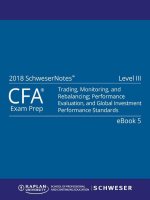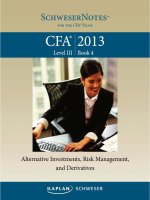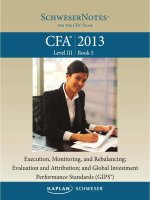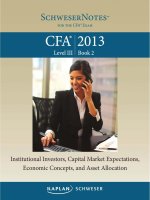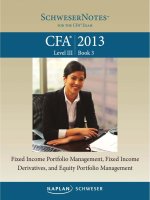2018 CFA level 1 study note book1
Bạn đang xem bản rút gọn của tài liệu. Xem và tải ngay bản đầy đủ của tài liệu tại đây (22.14 MB, 429 trang )
Table of Contents
1.
2.
3.
4.
5.
6.
7.
Getting Started Flyer
Table of Contents
Page List
Book 1 – Ethical & Professional Standards and Quantitative Methods
Welcome to the 2018 SchweserNotes
Reading Assignments and Learning Outcome Statements
Ethics and Trust in the Investment Profession
1. LOS 1.a: Explain ethics.
2. LOS 1.b: Describe the role of a code of ethics in defining a profession.
3. LOS 1.c: Identify challenges to ethical behavior.
4. LOS 1.d: Describe the need for high ethical standards in the investment
industry.
5. LOS 1.e: Distinguish between ethical and legal standards.
6. LOS 1.f: Describe and apply a framework for ethical decision making.
7. Key Concepts
1. LOS 1.a
2. LOS 1.b
3. LOS 1.c
4. LOS 1.d
5. LOS 1.e
6. LOS 1.f
8. Concept Checkers
1. Answers – Concept Checkers
8. Code of Ethics and Standards of Professional Conduct
1. LOS 2.a: Describe the structure of the CFA Institute Professional Conduct
Program and the process for the enforcement of the Code and Standards.
2. LOS 2.b: State the six components of the Code of Ethics and the seven
Standards of Professional Conduct.
3. LOS 2.c: Explain the ethical responsibilities required by the Code and
Standards, including the sub-sections of each Standard.
9. Guidance for Standards I-VII
1. LOS 3.a: Demonstrate the application of the Code of Ethics and Standards
of Professional Conduct to situations involving issues of professional
integrity.
2. LOS 3.b: Distinguish between conduct that conforms to the Code and
Standards and conduct that violates the Code and Standards.
3. LOS 3.c: Recommend practices and procedures designed to prevent
violations of the Code of Ethics and Standards of Professional Conduct.
4. Concept Checkers
1. Answers – Concept Checkers
10. Introduction to the Global Investment Performance Standards (GIPS)
1. LOS 4.a: Explain why the GIPS standards were created, what parties the
GIPS standards apply to, and who is served by the standards.
2. LOS 4.b: Explain the construction and purpose of composites in
performance reporting.
3. LOS 4.c: Explain the requirements for verification.
4. Key Concepts
1. LOS 4.a
2. LOS 4.b
3. LOS 4.c
11. The GIPS Standards
1. LOS 5.a: Describe the key features of the GIPS standards and the
fundamentals of compliance.
2. LOS 5.b: Describe the scope of the GIPS standards with respect to an
investment firm’s definition and historical performance record.
3. LOS 5.c: Explain how the GIPS standards are implemented in countries with
existing standards for performance reporting and describe the appropriate
response when the GIPS standards and local regulations conflict.
4. LOS 5.d: Describe the nine major sections of the GIPS standards.
5. Key Concepts
1. LOS 5.a
2. LOS 5.b
3. LOS 5.c
4. LOS 5.d
6. Concept Checkers
1. Answers – Concept Checkers
12. Self-Test Assessment: Ethical and Professional Standards
13. The Time Value of Money
1. Time Value of Money Concepts and Applications
2. LOS 6.a: Interpret interest rates as required rates of return, discount rates,
or opportunity costs.
3. LOS 6.b: Explain an interest rate as the sum of a real risk-free rate and
premiums that compensate investors for bearing distinct types of risk.
4. LOS 6.c: Calculate and interpret the effective annual rate, given the stated
annual interest rate and the frequency of compounding.
5. LOS 6.d: Solve time value of money problems for different frequencies of
compounding.
6. LOS 6.e: Calculate and interpret the future value (FV) and present value
(PV) of a single sum of money, an ordinary annuity, an annuity due, a
perpetuity (PV only), and a series of unequal cash flows.
7. LOS 6.f: Demonstrate the use of a time line in modeling and solving time
value of money problems.
8. Key Concepts
1. LOS 6.a
2. LOS 6.b
3. LOS 6.c
4. LOS 6.d
5. LOS 6.e
6. LOS 6.f
9. Concept Checkers
1. Answers – Concept Checkers
10. Challenge Problems
1. Answers – Challenge Problems
14. Discounted Cash Flow Applications
1. LOS 7.a: Calculate and interpret the net present value (NPV) and the
internal rate of return (IRR) of an investment.
2. LOS 7.b: Contrast the NPV rule to the IRR rule, and identify problems
associated with the IRR rule.
3. LOS 7.c: Calculate and interpret a holding period return (total return).
4. LOS 7.d: Calculate and compare the money-weighted and time-weighted
rates of return of a portfolio and evaluate the performance of portfolios
based on these measures.
5. LOS 7.e: Calculate and interpret the bank discount yield, holding period
yield, effective annual yield, and money market yield for US Treasury bills
and other money market instruments.
6. LOS 7.f: Convert among holding period yields, money market yields,
effective annual yields, and bond equivalent yields.
7. Key Concepts
1. LOS 7.a
2. LOS 7.b
3. LOS 7.c
4. LOS 7.d
5. LOS 7.e
6. LOS 7.f
8. Concept Checkers
1. Answers – Concept Checkers
9. Challenge Problems
1. Answers – Challenge Problems
15. Statistical Concepts and Market Returns
1. LOS 8.a: Distinguish between descriptive statistics and inferential statistics,
between a population and a sample, and among the types of measurement
scales.
2. LOS 8.b: Define a parameter, a sample statistic, and a frequency
distribution.
3. LOS 8.c: Calculate and interpret relative frequencies and cumulative
relative frequencies, given a frequency distribution.
4. LOS 8.d: Describe the properties of a data set presented as a histogram or a
frequency polygon.
2017-2018年最新CFA一级二级考点汇总中文版
(全)根据CFA最新考纲编写,比看notes还有效率
备考CFA的8大最有效资料和工具
教材/notes/核心词汇手册/考纲及解析手册/计算器讲
解、历年全真模拟题/真题/道德手册/QuickSheet/等等
全套资源获取方式随新考
季更新,永久有效!
PD
F里
所
有
资
料
扫
码
获
得
史上最全的学霸学渣党CFA考经笔记分享
扫码关注以上微信公众号:CFAer,回复
【资料】即可免费获取全套资源!此活动
永久有效!资料会常年实时更新!绝对全
面!
2017-2018年最新CFA视频音频课程及指南
除CFA资料外赠送金融、财会技能视频包+热门书籍
+1000G考证资料包
【CFA万人微信群】
需要加入我们CFA全球考友微信群的请添加CFA菌菌的微信号:374208596,备注需要加哪些
群~或直接扫下方CFA菌菌二维码即可~
所有人均先加入CFA全球考友总群再根据您的需求加入其他分群~
(2017年12月,2018年6打卡签到监督群,一级、二级、三级分群、上海、武汉、北京、成
都、南京、杭州、广州深圳、香港、海外等分群)!
备考资料、学霸考经、考试资讯免费共享!交流、答疑、互助应有尽有!快来加入我们吧!
群数量太多,文件中只是部分展示~有困难的话可以随时咨询我哦!
5. LOS 8.e: Calculate and interpret measures of central tendency, including
the population mean, sample mean, arithmetic mean, weighted average or
mean, geometric mean, harmonic mean, median, and mode.
6. LOS 8.f: Calculate and interpret quartiles, quintiles, deciles, and percentiles.
7. LOS 8.g: Calculate and interpret 1) a range and a mean absolute deviation
and 2) the variance and standard deviation of a population and of a
sample.
8. LOS 8.h: Calculate and interpret the proportion of observations falling
within a specified number of standard deviations of the mean using
Chebyshev’s inequality.
9. LOS 8.i: Calculate and interpret the coefficient of variation and the Sharpe
ratio.
10. LOS 8.j: Explain skewness and the meaning of a positively or negatively
skewed return distribution.
11. LOS 8.k: Describe the relative locations of the mean, median, and mode for
a unimodal, nonsymmetrical distribution.
12. LOS 8.l: Explain measures of sample skewness and kurtosis.
13. LOS 8.m: Compare the use of arithmetic and geometric means when
analyzing investment returns.
14. Key Concepts
1. LOS 8.a
2. LOS 8.b
3. LOS 8.c
4. LOS 8.d
5. LOS 8.e
6. LOS 8.f
7. LOS 8.g
8. LOS 8.h
9. LOS 8.i
10. LOS 8.j
11. LOS 8.k
12. LOS 8.l
13. LOS 8.m
15. Concept Checkers
1. Answers – Concept Checkers
16. Challenge Problems
1. Answers – Challenge Problems
16. Probability Concepts
1. LOS 9.a: Define a random variable, an outcome, an event, mutually
exclusive events, and exhaustive events.
2. LOS 9.b: State the two defining properties of probability and distinguish
among empirical, subjective, and a priori probabilities.
3. LOS 9.c: State the probability of an event in terms of odds for and against
the event.
4. LOS 9.d: Distinguish between unconditional and conditional probabilities..
5. LOS 9.e: Explain the multiplication, addition, and total probability rules.
6. LOS 9.f: Calculate and interpret 1) the joint probability of two events, 2) the
probability that at least one of two events will occur, given the probability
of each and the joint probability of the two events, and 3) a joint
probability of any number of independent events.
7. LOS 9.g: Distinguish between dependent and independent events.
8. LOS 9.h: Calculate and interpret an unconditional probability using the total
probability rule.
9. LOS 9.i: Explain the use of conditional expectation in investment
applications.
10. LOS 9.j: Explain the use of a tree diagram to represent an investment
problem.
11. LOS 9.k: Calculate and interpret covariance and correlation..
12. LOS 9.l: Calculate and interpret the expected value, variance, and standard
deviation of a random variable and of returns on a portfolio.
13. LOS 9.m: Calculate and interpret covariance given a joint probability
function.
14. LOS 9.n: Calculate and interpret an updated probability using Bayes’
formula.
15. LOS 9.o: Identify the most appropriate method to solve a particular
counting problem and solve counting problems using factorial,
combination, and permutation concepts.
16. Key Concepts
1. LOS 9.a
2. LOS 9.b
3. LOS 9.c
4. LOS 9.d
5. LOS 9.e
6. LOS 9.f
7. LOS 9.g
8. LOS 9.h
9. LOS 9.i
10. LOS 9.j
11. LOS 9.k
12. LOS 9.l
13. LOS 9.m
14. LOS 9.n
15. LOS 9.o
17. Concept Checkers
1. Answers – Concept Checkers
18. Challenge Problems
1. Answers – Challenge Problems
17. Common Probability Distributions
1. LOS 10.a: Define a probability distribution and distinguish between discrete
and continuous random variables and their probability functions.
2. LOS 10.b: Describe the set of possible outcomes of a specified discrete
random variable.
3. LOS 10.c: Interpret a cumulative distribution function.
4. LOS 10.d: Calculate and interpret probabilities for a random variable, given
its cumulative distribution function.
5. LOS 10.e: Define a discrete uniform random variable, a Bernoulli random
variable, and a binomial random variable.
6. LOS 10.f: Calculate and interpret probabilities given the discrete uniform
and the binomial distribution functions.
7. LOS 10.g: Construct a binomial tree to describe stock price movement.
8. LOS 10.h: Define the continuous uniform distribution and calculate and
interpret probabilities, given a continuous uniform distribution.
9. LOS 10.i: Explain the key properties of the normal distribution.
10. LOS 10.j: Distinguish between a univariate and a multivariate distribution
and explain the role of correlation in the multivariate normal distribution.
11. LOS 10.k: Determine the probability that a normally distributed random
variable lies inside a given interval.
12. LOS 10.l: Define the standard normal distribution, explain how to
standardize a random variable, and calculate and interpret probabilities
using the standard normal distribution.
13. LOS 10.m: Define shortfall risk, calculate the safety-first ratio, and select an
optimal portfolio using Roy’s safety-first criterion.
14. LOS 10.n: Explain the relationship between normal and lognormal
distributions and why the lognormal distribution is used to model asset
prices.
15. LOS 10.o: Distinguish between discretely and continuously compounded
rates of return and calculate and interpret a continuously compounded
rate of return, given a specific holding period return.
16. LOS 10.p: Explain Monte Carlo simulation and describe its applications and
limitations.
17. LOS 10.q: Compare Monte Carlo simulation and historical simulation.
18. Key Concepts
1. LOS 10.a
2. LOS 10.b
3. LOS 10.c
4. LOS 10.d
5. LOS 10.e
6. LOS 10.f
7. LOS 10.g
8. LOS 10.h
9. LOS 10.i
10. LOS 10.j
11. LOS 10.k
12. LOS 10.l
13. LOS 10.m
14. LOS 10.n
15. LOS 10.o
16. LOS 10.p
17. LOS 10.q
19. Concept Checkers
1. Answers – Concept Checkers
20. Challenge Problems
1. Answers – Challenge Problems
18. Sampling and Estimation
1. LOS 11.a: Define simple random sampling and a sampling distribution.
2. LOS 11.b: Explain sampling error.
3. LOS 11.c: Distinguish between simple random and stratified random
sampling.
4. LOS 11.d: Distinguish between time-series and cross-sectional data.
5. LOS 11.e: Explain the central limit theorem and its importance.
6. LOS 11.f: Calculate and interpret the standard error of the sample mean.
7. LOS 11.g: Identify and describe desirable properties of an estimator.
8. LOS 11.h: Distinguish between a point estimate and a confidence interval
estimate of a population parameter.
9. LOS 11.i: Describe properties of Student’s t-distribution and calculate and
interpret its degrees of freedom.
10. LOS 11.j: Calculate and interpret a confidence interval for a population
mean, given a normal distribution with 1) a known population variance, 2)
an unknown population variance, or 3) an unknown variance and a large
sample size.
11. LOS 11.k: Describe the issues regarding selection of the appropriate sample
size, data-mining bias, sample selection bias, survivorship bias, look-ahead
bias, and time-period bias.
12. Key Concepts
1. LOS 11.a
2. LOS 11.b
3. LOS 11.c
4. LOS 11.d
5. LOS 11.e
6. LOS 11.f
7. LOS 11.g
8. LOS 11.h
9. LOS 11.i
10. LOS 11.j
11. LOS 11.k
13. Concept Checkers
1. Answers – Concept Checkers
14. Challenge Problems
1. Answers – Challenge Problems
19. Hypothesis Testing
1. LOS 12.a: Define a hypothesis, describe the steps of hypothesis testing, and
describe and interpret the choice of the null and alternative hypotheses.
2. LOS 12.b: Distinguish between one-tailed and two-tailed tests of
hypotheses.
3. LOS 12.c: Explain a test statistic, Type I and Type II errors, a significance
level, and how significance levels are used in hypothesis testing.
4. LOS 12.d: Explain a decision rule, the power of a test, and the relation
between confidence intervals and hypothesis tests.
5. LOS 12.e: Distinguish between a statistical result and an economically
meaningful result.
6. LOS 12.f: Explain and interpret the p-value as it relates to hypothesis
testing.
7. LOS 12.g: Identify the appropriate test statistic and interpret the results for
a hypothesis test concerning the population mean of both large and small
samples when the population is normally or approximately normally
distributed and the variance is 1) known or 2) unknown.
8. LOS 12.h: Identify the appropriate test statistic and interpret the results for
a hypothesis test concerning the equality of the population means of two
at least approximately normally distributed populations, based on
independent random samples with 1) equal or 2) unequal assumed
variances.
9. LOS 12.i: Identify the appropriate test statistic and interpret the results for
a hypothesis test concerning the mean difference of two normally
distributed populations.
10. LOS 12.j: Identify the appropriate test statistic and interpret the results for
a hypothesis test concerning 1) the variance of a normally distributed
population, and 2) the equality of the variances of two normally distributed
populations based on two independent random samples.
11. LOS 12.k: Distinguish between parametric and nonparametric tests and
describe situations in which the use of nonparametric tests may be
appropriate.
12. Key Concepts
1. LOS 12.a
2. LOS 12.b
3. LOS 12.c
4. LOS 12.d
5. LOS 12.e
6. LOS 12.f
7. LOS 12.g
8. LOS 12.h
20.
21.
22.
23.
24.
25.
26.
27.
28.
29.
30.
9. LOS 12.i
10. LOS 12.j
11. LOS 12.k
13. Concept Checkers
1. Answers – Concept Checkers
14. Challenge Problems
1. Answers – Challenge Problems
Technical Analysis
1. LOS 13.a: Explain principles of technical analysis, its applications, and its
underlying assumptions.
2. LOS 13.b: Describe the construction of different types of technical analysis
charts and interpret them.
3. LOS 13.c: Explain uses of trend, support, resistance lines, and change in
polarity.
4. LOS 13.d: Describe common chart patterns.
5. LOS 13.e: Describe common technical analysis indicators (price-based,
momentum oscillators, sentiment, and flow of funds).
6. LOS 13.f: Explain how technical analysts use cycles.
7. LOS 13.g: Describe the key tenets of Elliott Wave Theory and the
importance of Fibonacci numbers.
8. LOS 13.h: Describe intermarket analysis as it relates to technical analysis
and asset allocation.
9. Key Concepts
1. LOS 13.a
2. LOS 13.b
3. LOS 13.c
4. LOS 13.d
5. LOS 13.e
6. LOS 13.f
7. LOS 13.g
8. LOS 13.h
10. Concept Checkers
1. Answers – Concept Checkers
Self-Test Assessment: Quantitative Methods
Self-Test Assessment: Quantitative Methods Answer Key
Formulas
Appendix A: Areas Under The Normal Curve
Cumulative Z-Table
Appendix B: Student’s t-Distribution
Appendix C: F-Table at 5 Percent (Upper Tail)
Appendix D: F-Table at 2.5 Percent (Upper Tail)
Appendix E: Chi-Squared table
Copyright
PAGE LIST
1.
2.
3.
4.
5.
6.
7.
8.
9.
10.
11.
12.
13.
14.
15.
16.
17.
18.
19.
20.
21.
22.
23.
24.
25.
26.
27.
28.
29.
30.
31.
32.
33.
34.
35.
36.
37.
38.
39.
40.
i
iii
iv
v
vi
vii
viii
ix
x
xi
xii
xiii
1
2
3
4
5
6
7
8
9
10
11
12
13
14
15
16
17
18
19
20
21
22
23
24
25
26
27
28
41.
42.
43.
44.
45.
46.
47.
48.
49.
50.
51.
52.
53.
54.
55.
56.
57.
58.
59.
60.
61.
62.
63.
64.
65.
66.
67.
68.
69.
70.
71.
72.
73.
74.
75.
76.
77.
78.
79.
80.
81.
82.
83.
84.
29
30
31
32
33
34
35
36
37
38
39
40
41
42
43
44
45
46
47
48
49
50
51
52
53
54
55
56
57
58
59
60
61
62
63
64
65
66
67
68
69
70
71
72
85.
86.
87.
88.
89.
90.
91.
92.
93.
94.
95.
96.
97.
98.
99.
100.
101.
102.
103.
104.
105.
106.
107.
108.
109.
110.
111.
112.
113.
114.
115.
116.
117.
118.
119.
120.
121.
122.
123.
124.
125.
126.
127.
128.
73
74
75
76
77
78
79
80
81
82
83
84
85
86
87
88
89
90
91
92
93
94
95
96
97
98
99
100
101
102
103
104
105
106
107
108
109
110
111
112
113
114
115
116
129.
130.
131.
132.
133.
134.
135.
136.
137.
138.
139.
140.
141.
142.
143.
144.
145.
146.
147.
148.
149.
150.
151.
152.
153.
154.
155.
156.
157.
158.
159.
160.
161.
162.
163.
164.
165.
166.
167.
168.
169.
170.
171.
172.
117
118
119
120
121
122
123
124
125
126
127
128
129
130
131
132
133
134
135
136
137
138
139
140
141
142
143
144
145
146
147
148
149
150
151
152
153
154
155
156
157
158
159
160
173.
174.
175.
176.
177.
178.
179.
180.
181.
182.
183.
184.
185.
186.
187.
188.
189.
190.
191.
192.
193.
194.
195.
196.
197.
198.
199.
200.
201.
202.
203.
204.
205.
206.
207.
208.
209.
210.
211.
212.
213.
214.
215.
216.
161
162
163
164
166
167
165
168
169
170
171
172
173
174
175
176
177
178
179
180
181
182
183
184
185
186
187
188
189
190
191
192
193
194
195
196
197
198
199
200
201
202
203
204
217.
218.
219.
220.
221.
222.
223.
224.
225.
226.
227.
228.
229.
230.
231.
232.
233.
234.
235.
236.
237.
238.
239.
240.
241.
242.
243.
244.
245.
246.
247.
248.
249.
250.
251.
252.
253.
254.
255.
256.
257.
258.
259.
260.
205
206
207
208
209
210
211
212
213
214
215
216
217
218
219
220
221
222
223
224
225
226
227
228
229
230
231
232
233
234
235
236
237
238
239
240
241
242
243
244
245
246
247
248
261.
262.
263.
264.
265.
266.
267.
268.
269.
270.
271.
272.
273.
274.
275.
276.
277.
278.
279.
280.
281.
282.
283.
284.
285.
286.
287.
288.
289.
290.
291.
292.
293.
294.
295.
296.
297.
298.
299.
300.
301.
302.
303.
304.
249
250
251
252
253
254
255
256
257
258
259
260
261
262
263
264
265
266
267
268
269
270
271
272
273
274
275
276
277
278
279
280
281
282
283
284
285
286
287
288
289
290
291
292
305.
306.
307.
308.
309.
310.
311.
312.
313.
314.
315.
316.
317.
318.
319.
320.
321.
322.
323.
324.
325.
326.
327.
328.
329.
330.
331.
332.
333.
334.
335.
336.
337.
338.
339.
340.
341.
342.
343.
344.
345.
346.
347.
348.
293
294
295
296
297
298
299
300
301
302
303
304
305
306
307
308
309
310
311
312
313
314
315
316
317
318
319
320
321
322
323
324
325
326
327
328
329
330
331
332
333
334
335
336
349.
350.
351.
352.
353.
354.
355.
356.
357.
358.
359.
360.
361.
362.
337
338
339
340
341
342
343
344
345
346
347
348
349
350
BOOK 1 – ETHICAL AND PROFESSIONAL STANDARDS
AND QUANTITATIVE METHODS
Reading Assignments and Learning Outcome Statements
Study Session 1 – Ethical and Professional Standards
Self-Test Assessment: Ethical and Professional Standards
Study Session 2 – Quantitative Methods: Basic Concepts
Study Session 3 – Quantitative Methods: Application
Self-Test Assessment: Quantitative Methods
Formulas
Appendices
WELCOME TO THE 2018 SCHWESERNOTES™
Thank you for trusting Kaplan Schweser to help you pass the Level I CFA exam. You
have made an exceptionally good decision, and we congratulate you for taking on the
challenge of earning your CFA charter.
Your first step should be to view the “How to Pass the Level I CFA Exam” video in the
Candidate Resource Library, in which we explain the structure of the exam, the
format of Level I exam questions, and topic area exam weights. We also provide
advice on study techniques based on learning science research, interpreting the
(500+) Level I CFA Learning Outcome Statements (LOS), and how to create an
effective study plan. Understanding the exact nature of the challenge you have taken
on is an important first step toward passing the Level I CFA exam.
The next step is to study and learn the material required for the exam. The best time
to begin that study is today (regardless of when you are reading this). Less than 40%
of those who register for a Level I exam pass the exam (including exam re-takers). For
many, passing the exam is a formidable challenge, and one of the reasons candidates
give most frequently for failing is “not starting early enough.”
Begin with Study Session 1, Ethical and Professional Standards, and progress through
Study Session 18, Alternative Investments. The five SchweserNotes books cover all
the LOS required for the exam. While they provide an excellent summary of the
required material for Study Session 1, we strongly recommend that, for this material,
all candidates also read the CFA Institute Standards of Practice Handbook (Reading 3
in the Level I CFA Curriculum, Volume 1) at the beginning of their study and again
shortly before the exam. Three of the ten topic areas will be the source for almost
half (47%) of the Level I exam questions: Ethical and Professional Standards,
Quantitative Methods, and Financial Reporting and Analysis.
For most candidates, repetition is essential to adequately learn and retain the
knowledge required for the exam across the ten diverse topic areas. We provide
video instruction for all of the readings, to supplement your study of the
SchweserNotes. The videos cover every LOS, in contrast to our classes, which focus
on the curriculum material candidates most often struggle with, include practice
questions and study tips, and develop links between different parts of the curriculum.
To gauge your progress and help you learn and retain the material, there are end-ofreading questions and topic area self-assessment tests in the SchweserNotes.
Additionally, our SchweserPro question bank (QBank) contains thousands of
questions for learning, practice, and review during your study period.
It is very important to finish your initial study of the entire curriculum at least a
month prior to your exam date and to use this time for a review course, and to take
several practice exams including the SchweserMock exam, which is offered by CFA
Societies in over 100 locations around the world and online. This final month is when
you will get an indication of how effective your study has been and find out which
topic areas require significant additional review on your part. Additionally, practice
answering exam-like questions across all topics and work on your exam timing. These
will be important determinants of your success on exam day.
I would like to thank Craig Prochaska, CFA, who, as my assistant, has been invaluable
in the preparation of all our Level I study materials and candidate support for over 10
years. Craig and I will be answering your questions and supporting your study
throughout the exam season.
Best regards,
Doug Van Eaton
Doug Van Eaton, PhD, CFA
READING ASSIGNMENTS AND LEARNING OUTCOME
STATEMENTS
The following material is a review of the Ethical and Professional Standards and
Quantitative Methods principles designed to address the learning outcome
statements set forth by CFA Institute.
STUDY SESSION 1
Reading Assignments
Ethical and Professional Standards and Quantitative Methods, CFA Program Level I
2018 Curriculum (CFA Institute, 2017)
1. Ethics and Trust in the Investment Profession
2. Code of Ethics and Standards of Professional Conduct
3. Guidance for Standards I–VII
4. Introduction to the Global Investment Performance Standards (GIPS®)
5. The GIPS Standards
STUDY SESSION 2
Reading Assignments
Ethical and Professional Standards and Quantitative Methods CFA Program Level I
2018 Curriculum (CFA Institute, 2017)
6. The Time Value of Money
7. Discounted Cash Flow Applications
8. Statistical Concepts and Market Returns
9. Probability Concepts
STUDY SESSION 3
Reading Assignments
Ethical and Professional Standards and Quantitative Methods CFA Program Level I
2018 Curriculum (CFA Institute, 2017)
10. Common Probability Distributions
11. Sampling and Estimation





